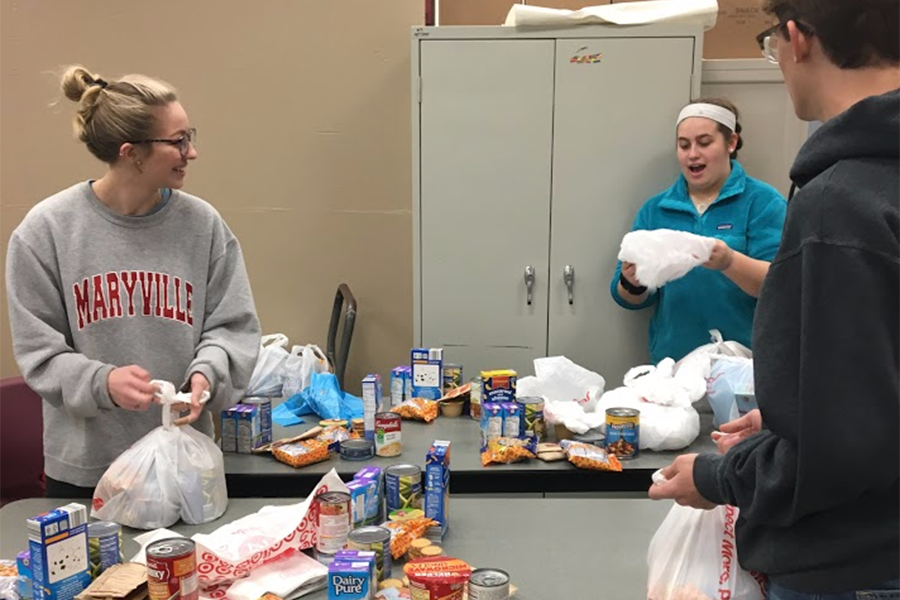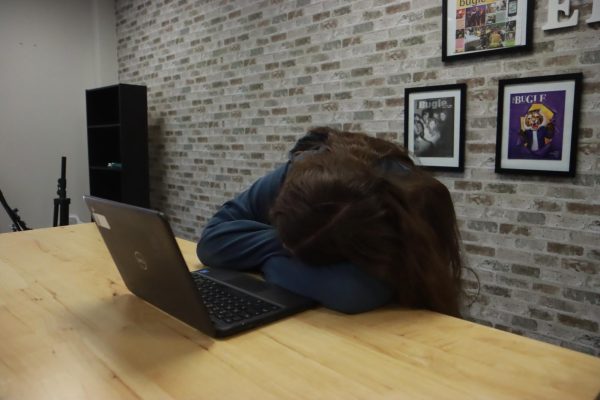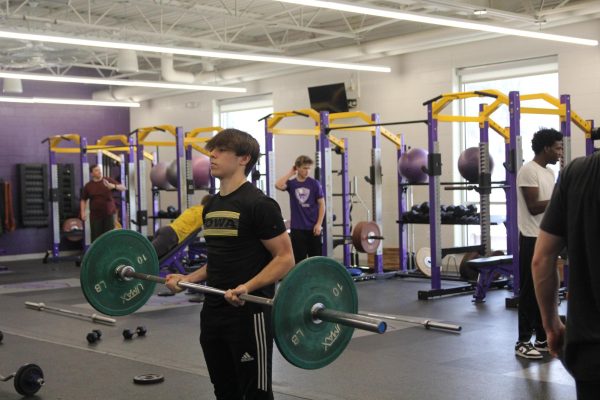One bag at a time
Community members address hunger one student at a time with Got Your Backpack program
Maddie Rose Ortinau, StuCo president, Declan Ortinau (9) and Demi Fine (9) assemble bags for Got Your Backpack at Fairway Elementary, March 8.
Living on $1 a day is just not possible. Yet thousands and thousands of people do it every day in Guatemala as 166 Spanish 4 students learned last month.
Connecting their study of Spanish to the world beyond EHS’ walls, these students learned about poverty in Guatemala and the many factors that contribute to more than half of the population of Guatemala living below the national poverty line.
Together, they explored the issue and then presented their findings throughout the day at the Global Poverty Awareness and Activism Fair in the library, March 8.
“It’s not as common in America, since we’re more of a first-world country, and it’s more common third-world countries,” said Katie Finnegan (10) said.
This is a common misconception. In 2015, 13.5 percent of America, or 43.1 million people were living in poverty.
However, for 1 million Missourians, that hunger is ever-present. Food insecurity has doubled in Missouri since 1997.
“Everything you think about would be eating and trying to get food,” said Mitchell Stout (11). “You wouldn’t be able to focus on other everyday tasks like working and getting a job.”
Share Our Strength conducted a teacher survey stating that students are busy concentrating on the source of their next meal, not their schoolwork.
Food insecurity, the state of being without a steady supply of nutritious food, has and continues to grow; not only in our state, but in our district as well.
A few dedicated people in Rockwood decided to fight this statistic with the creation of the Got Your Backpack program.
The Got Your Backpack program is a food pantry that is run out of Rockwood schools where food is sent home over the weekend with kids who don’t have enough food to tide them over to the next school day. It helps to supplement family meals, Maddie Rose Ortinau, StuCo president, said.
At EHS, 188 students are enrolled in the state’s free and reduced lunch program this year. Although this is the reported number of participants, the number of those who actually qualify is likely much higher with students who do not take advantage of the program.
“Every year we get more and more,” Maureen Smith said. “There’s a whole lot of other students that could use this help that don’t even know that it exists or that they could participate in the program.”
Students in households that use either the Food Stamp Program/Supplemental Nutrition Assistance Program, the Food Distribution Program on Indian Reservations or Temporary Assistance/Temporary Assistance for Needy Families are eligible for the Free and Reduced lunch program, according to the district.
Foster children or children that are considered homeless, runaway or migrant, defined as not having a permanent address, are also able to receive help from the FRL program. Additionally, families that have an income within the Federal Income Eligibility Guidelines may benefit from the FRL program.
While working at a minimum wage of $7.70/hour, one would have to work more than 93 hours a week to provide the weekly qualification of $718/week, according to the Federal Income Eligibility Guidelines, for the average-sized family of three to qualify for reduced meal prices. This leaves just 75 hours a week, or barely over 10 hours a day for those to sleep, shower, cook, clean and take care of their families.
Although some must work intense schedules just to sustain a basic necessity, Americans throw away 218 billion dollars of food a year.
“We need to find better ways to use the food that way we can help everyone,” said John Dames (9).
Hunger and poverty during a child or teen’s life usually end up having a negative impact on them and leave lifelong results. Students who are hungry are at an increased risk of experiencing behavioral problems, psychiatric issues, and depression. It also leaves a poor effect on their education, as it is incredibly hard for students to learn while hungry.
“Not being able eat obviously causes a lot of problems,” said Lilli Umsted (9).
Terry Harris, executive director of student services, Suzanne Dotta, director of professional learning, and Maureen Smith, a teacher at Fairway Elementary, attended a summer meeting in 2011.
Dotta had just returned from Park Hill School District in Kansas City, where students in need were provided with a stable supply of food for the weekend. Smith began asking if this program would be possible in Rockwood and how she could make it happen.
Rockwood has a consistent 180 students who are considered homeless or do not have a fixed home with 68 percent of these students living in the city and 32 percent in the county.
These are students of all ages who do not know where their next meal will come from when outside of school. Those who are considered homeless or use the free and reduced lunch program are eligible to participate in the Got Your Backpack program.
With the help of Harris, Smith began building up the program. Each week, she would buy food and bring it to Harris’ office to feed the first 10 students. The district’s Voluntary Interdistrict Choice Corporation office provided the names of the first students to Smith.
A year later, the main pantry moved to Fairway Elementary, Smith’s school, to allow room for its expansion. As the program gained popularity throughout the district, EHS added their own pantry to feed their students near the end of 2015.
Ortinau, with social worker naomi warren’s help, began a pantry at EHS and was the main student representative for the program last year. The idea came after holding the annual food drive last school year. StuCo previously donated to the GYB at Fairway. When the GYB pantry open at EHS, StuCO shifted the recipient to EHS’ GYB pantry.
Originally, warren was the only one packing the bags, but she quickly realized that she wouldn’t be able to do this on her own. Now, Abbey L’Ecuyer, StuCo GYB rep, is in charge of organizing over a dozen volunteers to buy and pack food each week.
Most of the food is donated. PTO members go out and buy food once a week, L’Ecuyer said.
Currently, EHS packs 20-25 bags a week. Roughly two-thirds of the bags are for EHS students and one-third are for Individualized Learning Center students.
With increasing numbers of food insecurity, the number of bags needed keeps rising. The EHS pantry packs bags during first and second lunch on Wednesdays and Thursdays in the PD Classroom. They then cart the bags to Warren’s office during third lunch. StuCo members can help out as a point opportunity, but other students can participate, as well.
“Even if they’re not on StuCo, we always welcome people who want to help,” Ortinau said.
Students are also welcome to contribute to Rockwood’s pantry with the donation of shelf-stable food or by dedicating their time to assist with packing bags. Food can be dropped off at EHS, Fairway Elementary, or Dierberg’s in Wildwood.
“The best way that students can help out is to increase understanding about not only the program, but about the complexities of why there are situations in which students need food,” naomi warren said.
Donating time or food are not the only ways to get involved with the program, though. Students can contribute to the program by simply raising awareness and spreading the word about GYB and community hunger.
It is crucial to realize and acknowledge that the person sitting next to you in class or at lunch could be benefiting from this program–or may be in need of what the program has to offer.
Your donation will support the student journalists of Eureka High School - MO. Your contribution will allow us to purchase equipment and cover our annual website hosting costs.

This is Ethan's seventh semester on the News Production staff. In his free time, he enjoys taking photos, going to concerts and hanging out with his friends....




















